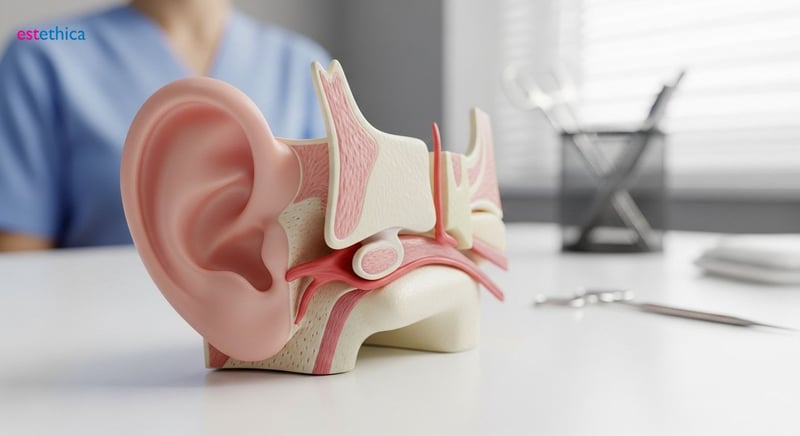Otoplasty Unveiled: Crafting Harmony Through Ear Surgery
Explore the transformative power of otoplasty. Enhance your appearance with advanced ear surgery techniques.
Otoplasty, commonly referred to as ear surgery, is a transformative journey towards achieving harmony and balance in facial aesthetics. This surgical procedure primarily focuses on reshaping the ears to enhance facial symmetry, catering to both adults and children alike. With growing interest in cosmetic enhancements, otoplasty has gained popularity for its ability to correct protruding ears, improve self-esteem, and align with aesthetic desires. This comprehensive guide explores various aspects of otoplasty, shedding light on the techniques, recovery, and impact it can have on an individual's confidence and appearance.
Understanding Otoplasty: More Than Just Ear Pinning
Unveiling the Comprehensive Nature of Ear Surgery
Otoplasty extends beyond just addressing protruding ears; it's a sophisticated surgical solution designed to correct a range of aesthetic and structural ear issues. This transformative procedure addresses congenital defects, trauma-induced deformities, and general dissatisfaction with ear appearance. A primary goal of Otoplasty is to ensure the ears harmonize with the individual's facial features, creating a balanced and natural aesthetic. Techniques include strategic incisions, meticulous cartilage remodeling, and precise suturing to achieve the desired outcome, tailored to each patient's unique anatomy.
Beyond the standard ear pinning, otoplasty encompasses procedures like ear reduction to address overly large ears and earlobe repair to correct damage from piercings or injuries. The versatility of this surgery makes it a popular choice for individuals seeking enhanced self-esteem and improved social interactions. Consulting with a skilled surgeon is essential for aligning patient expectations with the realistic possibilities of the surgery and ensuring the best possible results. The impact of otoplasty goes beyond mere physical alteration; it often leads to a significant boost in self-perception and confidence.
Exploring the Subtypes and Benefits of Otoplasty
Otoplasty isn't a one-size-fits-all procedure; it's a spectrum of techniques tailored to individual needs. Consider a patient with macrotia, a condition where the ears are disproportionately large. Otoplasty can reduce the size of the ears, bringing them into better proportion with the face. In another scenario, a patient may have suffered a torn earlobe due to heavy earrings; earlobe repair, a subtype of otoplasty, can restore the earlobe's natural shape. For individuals with Stahl's ear, characterized by a pointed ear shape, otoplasty can reshape the cartilage for a more rounded appearance. These examples highlight the adaptability of otoplasty to address various ear-related concerns.
- Enhanced Facial Harmony: The primary aim is to create a natural, balanced appearance.
- Versatile Correction: Addresses a range of issues, from size reduction to shape correction.
- Improved Confidence: Many patients report a significant boost in self-esteem following surgery.
Patients seeking procedures such as Otoplasty, Ear Surgery, and Cosmetic Ear Surgery often find that these procedures contribute not only to their physical appearance but also to their overall sense of well-being. Effective communication with your surgeon ensures that the Otoplasty cost aligns with your expectations for the Otoplasty surgery.

Adult Ear Reshaping: Reclaiming Confidence Through Cosmetic Ear Surgery
Why Choose Otoplasty in Adulthood?
For many adults, the decision to undergo otoplasty stems from a desire to correct issues that have affected their self-esteem for years. Unlike children, adults possess a clearer understanding of the procedure, the expected outcomes, and the commitment required for recovery. This informed perspective often leads to higher satisfaction rates. Adult otoplasty offers a chance to address concerns that may have influenced personal and professional interactions, paving the way for renewed confidence and self-acceptance. The procedure is particularly appealing for those who have postponed it due to previous commitments, now finding themselves in a more stable position to prioritize their well-being.
- Enhanced Self-Image: Correcting ear abnormalities boosts overall confidence.
- Greater Understanding: Adults make informed decisions with realistic expectations.
- Improved Social Comfort: Addressing long-standing concerns enhances social interactions.
Navigating Otoplasty as an Adult: What to Expect
Adults considering ear surgery should anticipate a comprehensive consultation process, where a surgeon assesses their ear structure and discusses their aesthetic goals. The surgery, commonly performed using local anesthesia, involves reshaping or repositioning the ear cartilage through small incisions. Post-operative care is crucial for optimal healing and involves wearing a bandage to protect the ears. While individual experiences vary, many patients return to work within a week. The emotional benefits are significant; many individuals experience a marked improvement in their confidence and body image. estethica Global offers detailed pre- and post-operative support and guidance, ensuring that patients feel comfortable and well-informed throughout their otoplasty journey. By prioritizing patient education and personalized care, estethica Global ensures a positive and empowering experience, allowing adults to achieve the aesthetic improvements they desire with confidence and peace of mind.
- Detailed Consultation: Thorough assessment and personalized planning.
- Minimally Invasive: Often performed under local anesthesia, reducing downtime.
- Comprehensive Support: Full guidance from initial consultation to post-operative care.

Pinnaplasty Techniques: Achieving Natural-Looking Results
Customizing Pinnaplasty for Optimal Aesthetic Outcomes
Pinnaplasty, a refined form of Otoplasty, meticulously sculpts the ear to achieve a natural and harmonious appearance. This personalized approach to ear reshaping involves a detailed understanding of each patient’s unique ear anatomy and aesthetic desires. Surgeons employ advanced techniques to ensure the repositioned ears complement the individual’s facial features seamlessly. Effective communication is essential, allowing surgeons to align their approach with the patient’s vision, thus enhancing satisfaction. The goal is to provide subtle yet impactful changes that boost self-confidence and improve overall quality of life.
The success of Cosmetic Ear Surgery is amplified through tailored planning and execution, ensuring the final results not only meet but exceed patient expectations. Consider the case of a patient with naturally stiff ear cartilage; the surgeon might employ scoring techniques to gently soften and reshape the cartilage, achieving a more natural curve. In another instance, a patient with asymmetrical ear protrusion might require varying degrees of correction on each ear to achieve perfect balance. Additionally, for individuals seeking a less invasive approach, options like suture-only methods provide subtle adjustments without extensive excisions. The key is adapting the pinnaplasty technique to match the patient's specific needs and anatomical characteristics.
Technological Advancements and Post-Surgical Expectations in Pinnaplasty
Modern pinnaplasty benefits significantly from technological advancements that enhance precision and reduce recovery time. For instance, the use of 3D modeling allows surgeons to visualize and plan the surgery with enhanced accuracy, ensuring optimal aesthetic outcomes. These technologies enable the creation of custom surgical guides, which help in precisely reshaping the cartilage. Effective post-operative care is essential. Wearing a specialized headband helps maintain the new ear position and minimizes swelling. With improvements in surgical techniques, scarring is minimized, and many patients experience minimal discomfort during recovery. According to recent studies, over 95% of patients who undergo pinnaplasty report satisfaction with the aesthetic results.
- 3D Modeling: Enhances surgical planning for precise outcomes.
- Custom Surgical Guides: Ensures accurate cartilage reshaping.
- Specialized Headbands: Aids in maintaining new ear position post-surgery.
- Enhance Symmetry: Balances ear position for facial harmony.
- Minimize Scarring: Advanced techniques for subtle post-surgical marks.
- Boost Appearance: Improves overall aesthetic and confidence.

Otoplasty Recovery: What to Expect and How to Optimize Healing
Immediately Post-Operative Care Following Ear Surgery
Immediately following Otoplasty, patients can anticipate some degree of discomfort coupled with swelling around the ears. Typically, this initial phase requires diligent care to mitigate complications. Protective dressings are applied to support the newly reshaped ears and manage swelling. Patients receive specific instructions, including how to manage pain effectively. It's essential to keep the head elevated during rest to minimize swelling. Avoiding strenuous activities is critical to ensuring that the healing process is not compromised. Most patients report that discomfort is manageable with prescribed medication.
Proper wound care is also crucial in these early stages. This involves regularly cleaning the incision sites as directed by the surgeon and monitoring for any signs of infection, such as increased redness, swelling, or discharge. Following these instructions closely can significantly reduce the risk of complications and promote a smooth recovery. For example, a patient who carefully adheres to the cleaning regimen and avoids touching the surgical sites is less likely to develop an infection. Another important aspect is ensuring adequate hydration and nutrition to support the body's natural healing processes. estethica Global provides comprehensive aftercare guidelines and support, assisting patients through each step of the immediate post-operative period to optimize healing and comfort.
Long-Term Strategies for Successful Otoplasty Recovery
Long-term recovery from ear surgery involves adopting strategies that support lasting results and overall well-being. One key aspect is maintaining consistent follow-up appointments with the surgeon to monitor healing progression and address any concerns that may arise. Patients are generally advised to avoid contact sports or activities that could potentially traumatize the ears for several months post-surgery. Protecting the ears from sun exposure is also important, as this can affect scar healing and appearance. In addition, incorporating regular, gentle ear massages, as advised by the surgeon, can help reduce scar tissue formation and improve the overall texture of the treated area. Studies show that patients who actively participate in their recovery and adhere to long-term care recommendations tend to experience the best outcomes, with minimized risks of complications and enhanced satisfaction with their Otoplasty results.
- Consistent Follow-Ups: Regular check-ins ensure proper healing.
- Sun Protection: Prevents scar discoloration for better aesthetic results.
- Gentle Ear Massages: Minimizes scar tissue and improves texture.
- Hydration and Nutrition: Supports natural healing processes.
- Infection Monitoring: Promptly address any signs of infection.
- Activity Avoidance: Refrain from strenuous activities to prevent complications.
Understanding Otoplasty: A Comprehensive Guide
Meticulous Cartilage Remodeling and Suturing: Achieving Harmonious Facial Aesthetics through Otoplasty
3D Modeling Precision: Minimizing Scarring and Maximizing Beauty in Pinnaplasty
Frequently Asked Questions
What is otoplasty and what issues can it address?
What does the recovery process entail after undergoing otoplasty?
How do adults benefit from undergoing ear reshaping surgery?
What is pinnaplasty and how does it help in achieving natural-looking results?
Achieve your aesthetic goals with estethica's personalized treatment plans and expert care.
📞 Book Your Free Consultation!